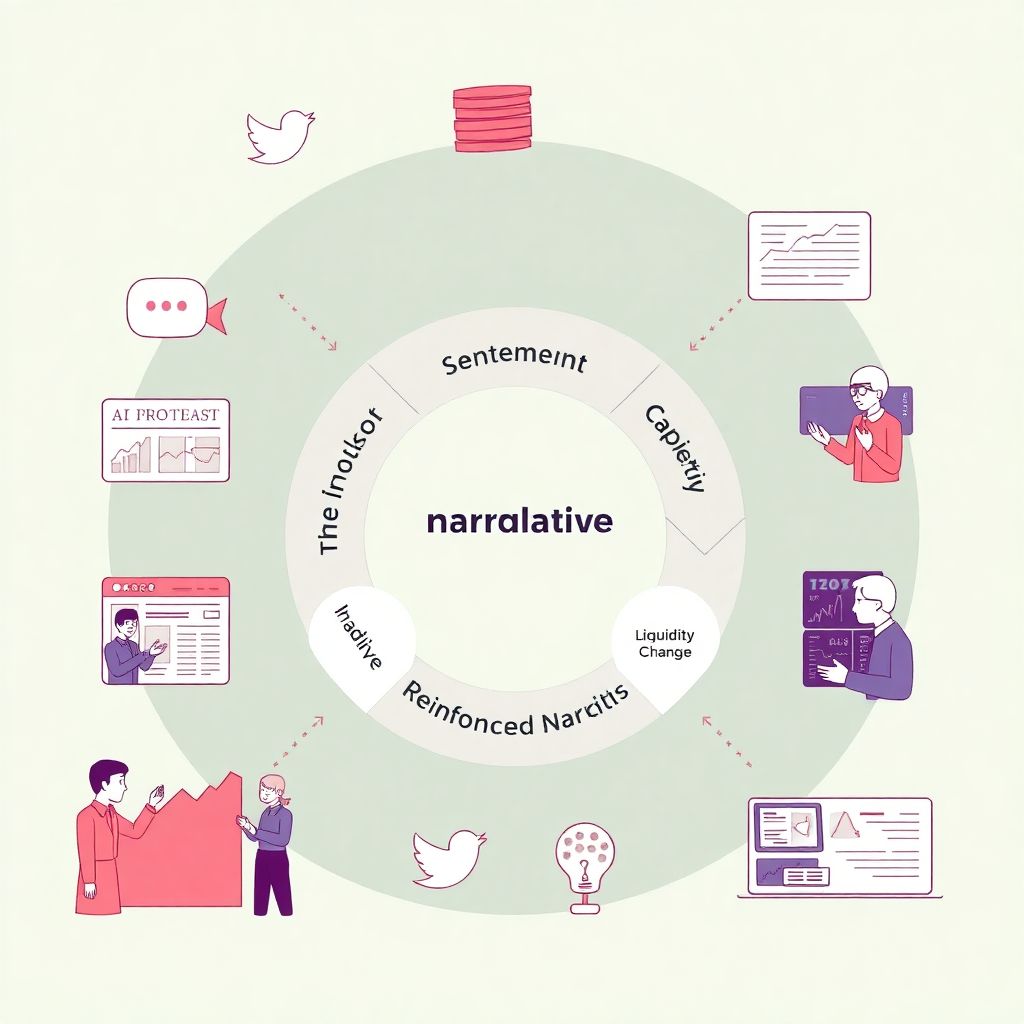Understanding Narratives in Financial Markets
In financial markets, a *narrative* isn’t just a story—it’s a powerful framework that shapes investor sentiment, drives capital allocation, and influences liquidity. A narrative can be as broad as “AI will transform every industry,” or as specific as “Interest rate cuts are imminent.” These stories, whether grounded in data or speculation, act as psychological anchors for decision-making. Unlike charts or earnings reports, narratives simplify complexity, allowing investors to form opinions and act quickly.
Market *liquidity*, on the other hand, refers to how easily assets can be bought or sold without causing significant price changes. High liquidity means trades happen smoothly; low liquidity implies slippage and volatility. Narratives impact liquidity by attracting or repelling flows. When a compelling story gains traction—say, the “Green Energy Revolution”—investors pile in, increasing both volume and liquidity in related assets. Conversely, when stories collapse (like the crypto winter of 2022), liquidity dries up fast.
How Stories Translate Into Market Flows
Narratives drive flows through a feedback loop. Here’s how it works:
1. Emergence: A new idea or shift in perception gains attention (e.g., “AI will replace white-collar jobs”).
2. Adoption: Influencers, analysts, and media amplify the story.
3. Capital Movement: Investors reallocate portfolios in line with the narrative.
4. Price Reaction: Assets tied to the story surge or fall.
5. Liquidity Shift: More participants enter or exit, affecting bid-ask spreads and depth.
This cycle can be visualized as a circular diagram:
Narrative → Sentiment → Capital Flow → Price Movement → Liquidity Change → Reinforced Narrative
Take the 2023 boom in semiconductor stocks. The narrative was simple: “AI needs chips.” As ChatGPT and other models dominated headlines, investors rushed into NVIDIA, AMD, and TSMC. Prices soared, trading volumes spiked, and liquidity in those tickers deepened. The story fed itself.
Comparing Narratives to Traditional Fundamentals

Traditional valuation models focus on metrics like discounted cash flows, P/E ratios, or EBITDA. These tools assume rational actors and long-term horizons. Narratives, by contrast, often operate on shorter timeframes and behavioral biases. They don’t replace fundamentals—but in many cases, they override them.
Let’s compare:
– Fundamentals: Data-driven, slow-moving, often lagging.
– Narratives: Emotion-driven, fast-moving, often leading.
A good example is Tesla. For years, its valuation defied traditional metrics. The narrative—”Tesla is more than a car company”—sustained its market cap despite volatile earnings. Investors believed in Elon Musk’s vision, and that belief created liquidity.
Examples of Narrative-Driven Liquidity Shifts
Let’s explore a few real-world cases where narratives reshaped liquidity:
1. COVID-19 (2020): The “work-from-home” narrative lifted Zoom, Peloton, and DocuSign. Liquidity in these stocks exploded as retail and institutional investors chased the trend.
2. ESG Investing (2021): The idea that “sustainable companies will outperform” pushed massive flows into green ETFs. Liquidity in clean energy stocks surged—until the narrative cooled.
3. AI Boom (2023–2024): As generative AI tools went viral, semiconductor and cloud infrastructure companies became liquidity magnets.
In all these cases, stories—not just earnings—moved the market.
Why Narratives Matter More in 2025
As of 2025, we’re seeing narratives become even more central to market dynamics. Social media, real-time news, and algorithmic trading amplify stories at a speed that was impossible a decade ago. Platforms like X (formerly Twitter) and TikTok finance channels now shape sentiment faster than Bloomberg terminals.
Retail investors, empowered by zero-commission trading and AI-driven tools, react to narratives in real time. This creates flash liquidity events—brief windows where assets become highly liquid due to a viral story, only to revert quickly when attention fades.
Moreover, machine learning models used by hedge funds now scan narrative sentiment as a key input. They analyze language in earnings calls, news articles, and Reddit threads to anticipate flow shifts. This means narratives are not just psychological—they’re quantifiable.
Looking Ahead: The Future of Narrative-Driven Liquidity
In the next 3–5 years, we expect narratives to become even more measurable and tradable. Here’s a forecast of how this trend might evolve:
1. Narrative Indices: Just like volatility or sentiment indices, we may see products that track the strength of specific market narratives.
2. Tokenized Stories: With blockchain adoption, narratives could be embedded into smart contracts—where capital flows automatically based on trigger conditions tied to news or data.
3. AI Narratives vs. Human Narratives: As generative AI starts writing headlines and analysis, the line between organic and engineered stories will blur. This could create synthetic liquidity events.
4. Narrative Arbitrage: Funds may begin trading mismatches between dominant narratives and underlying fundamentals, betting on story reversals.
Ultimately, the market of 2025 is not just about numbers, but about belief systems. Those who understand how stories shape liquidity—and who can quantify and react to them—will hold a significant edge.
Conclusion: The Power of Narrative in a Liquid World

Narratives aren’t fluff—they’re the fuel behind market momentum and liquidity shifts. In 2025, with information moving faster than ever, understanding the mechanics of story-driven flows is essential. Whether you’re a trader, portfolio manager, or policymaker, recognizing the role of narratives can help you navigate volatility, spot opportunities early, and avoid the traps of herd behavior. The future belongs to those who can read between the headlines.

